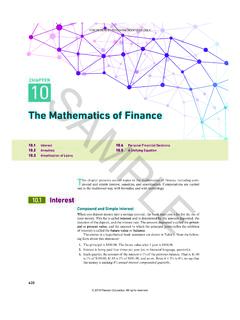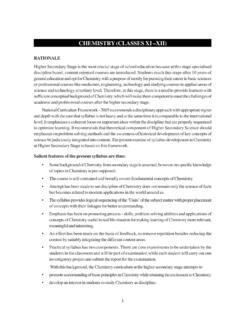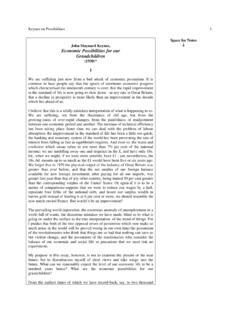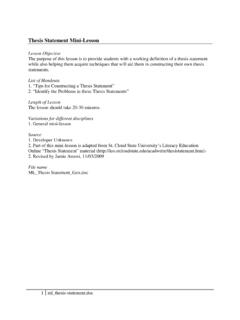Transcription of Simple and Compound Interest - webbertext.com
1 8 Simple and CompoundInterestInterest is the fee paid for borrowed money. We receiveinterest when we let others use our money (for example, bydepositing money in a savings account or making a loan).We payinterest when we use other people s money (suchas when we borrow from a bank or a friend). Are you a receiver or a payer ?In this chapter we will study Simple and compoundinterest. Simple interestis Interest that is calculated onthe balance owed but not on previous Interest . Compoundinterest, on the other hand, is Interest calculated on anybalance owed including previous Interest . Interest for loansis generally calculated using Simple Interest , while interestfor savings accounts is generally calculated using com-pound concepts of this chapter are used in many upcom-ing topics of the text.
2 So hopefully you have interestin mas-tering the stuff in this Computing Simple Interest andmaturity value aComputing Simple Interest and maturity value loans stated in months or years bCounting days and determining maturity date loans stated in days cComputing Simple Interest loans stated in daysUnit solving for principal, rate, and time aSolving for P(principal) and T(time) bSolving for R(rate)Unit Compound Interest aUnderstanding how Compound Interest differs fromsimple Interest bComputing Compound Interest for different com-pounding periods151On July 10, 2005, Wendy Chapman borrowed $12,000 from her Aunt Nelda. If Wendy agreed topay a 9% annual rate of Interest , calculate the dollar amount of Interest she must pay if the loan isfor(a) 1 year, (b)5 months, and (c)15 year:I= PRT= $12,000 9% 1 = $1, months:I= PRT= $12,000 9% 5 12= $ months:I= PRT= $12,000 9% 1512= $1,350We can do the arithmetic of Example 1 with a calculator:what is PRT?
3 152 Chapter 8 Simple and Compound InterestUnit Computing Simple Interest and maturity valueWendy Chapman just graduated from college witha degree in accounting and decided to open herown accounting office (she can finally start earningmoney instead of paying it on college). On July 10,2005, Wendy borrowed $12,000 from her AuntNelda for office furniture and other start-up agreed to repay Aunt Nelda in 1 year, togetherwith Interest at 9%.The original amount Wendy borrowed $12,000 is the principal. The percent thatWendy pays for the use of the money 9% is therate of Interest (or simply the Interest rate). Thelength of time 1 year is called the timeorterm. The date on which the loan is to be repaid July 10, 2006 is called the due dateor maturitydate. The total amount Wendy must repay (whichwe will calculate later) consists of principal($12,000) and Interest ($1,080); the total amount($13,080) is called the maturity value.
4 AComputing Simple Interest and maturity value loans stated in months or yearsTo calculate Interest , we first multiply the principal by the annual rate of Interest ; this gives us inter-est per year. We then multiply the result by time (in years).Example 1 Remember, when symbols are written side by side, it means to multiply, so PRTmeans P R T. Also,don t forget R, the Interest rate, is the annualrate; and Tis expressed in years(or a fraction of a year).TIPI= PRTI= Dollar amount of Interest P= Principal R= Annual rate of Interest T= Time (in years) Simple Interest formula=Banks provide a valuable service as money bro-kers. They borrow from some people (throughsavings accounts, etc.) and loan that samemoney to others (at a higher rate). Some ofthese loans are Simple Interest (for most calculators)12,000 9% =1, ,000 9% 5 12= ,000 9% 15 12=1, to Example 1.
5 Calculate the maturity value if the 9% $12,000 loan is for (a)1 year, (b)5months, and (c)15 year:M= P+ I= $12,000 + $1,080 = $13, months:M= P+ I= $12,000 + $450 = $12, months:M= P+ I= $12,000 + $1,350 = $13,350 Wendy must pay a total of $13,080 if the loan is repaid in 1 year (July 10, 2006), $12,450 if the loanis repaid in 5 months (December 10, 2005), and $13,350 if the loan is repaid in 15 months (October10, 2006).Unit Computing Simple Interest and maturity value153 Example 2To find the maturity value, we simply add Interest to the P+ IM= Maturity value P= Principal I= Dollar amount of interestmaturity value formula= bCounting days and determining maturity date loans stated in daysIn Examples 1 and 2, the term was stated in months or years. Short-term bank loans often have aterm stated in days (such as 90 or 180 days) rather than months.
6 Before calculating the amount ofinterest for these loans, we must know how to count days. One method is to look at a regular calen-dar and start counting: the day afterthe date of the loan is day 1, and so on. However, that methodcan be time-consuming and it is easy to make a mistake along the way. We will, instead, use a day-of-the-year calendar, shown as Appendix D; pay special attention to the entertaining footnote. In theday-of-the-year calendar, each day is numbered; for example, July 10 is day 191 (it is the 191st dayof the year). The next example shows how to use a day-of-the-year (a)90 days from September 10, 2006;(b)180 days from September 10, 2006; and (c) 180days from September 10, 10 Day253+90 Dec. 9 10 Day253+180433(This is greater than 365, so we must subtract 365)-365 Mar. 9 10 Day253+180433(This is greater than 365, so we must subtract 365)-365 Mar.
7 8 68(Because this is a leap year, March 8 is day 68)In parts (b) and (c) of Example 3, we found that the final date was the 68th day of the year. Fora non-leap year, the 68th day is March 9. With a leap year, like 2008, there is an extra day in Februaryso March 9 is day 69; March 8 is day number optional method for counting days is known as the days-in-a-month method. With thismethod, we remember how many days there are in each month; the method is shown in AppendixD, page D-2. While a day-of-the-year calendar is often easier to use, understanding the days-in-a-month method is important because we may not always have a day-of-the-year calendar with is how we could do Example 3, part (c), using the days-in-a-month method:Example 3154 Chapter 8 Simple and Compound InterestIn the next example, we ll figure out how many days between two dates.
8 For some of us, thereare quite a few days between dates (oops, wrong kind of date).Find the number of days between each set of dates:(a)July 24 to November 22, (b)July 24 to March13 of the following year (non-leap year), and (c)July 24 to March 13 (leap year). 22 Day326(Last day is minuend, on top)July 24 Day -205121 of days left in first year: 365 - 205 (day number for July 24) 160 Number of days in next year: Mar. 13 +72232 of days left in first year: 365 - 205 (day number for July 24) 160 Number of days in next year: Mar. 13 72 + 1 (for leap year) +73233 daysExample 4In part (b) of Example 4 (non-leap year), March 13 is day 72. But with a leap year in part (c),there is an extra day in February, making March 13 day 73, not day is how we could do Example 4, part (c), using the days-in-a-month method:Days between July 24 and March 13 (a leap year)?
9 Days in July: 31 - 24 =7 July has 31 days; not charged Interest for first 24 daysDays in August31 Days in September30 Days in October31 Days in November30 Days in December31 Days in January31 Days in February (leap year)29 Days in March+ 13 Total233 days180 days from September 10, 2007?Days left in September: 30 - 10 =20 September has 30 days; not charged Interest for first 10 daysDays in October+ 31 Subtotal51 Days in November+ 30 Subtotal81 Days in December+ 31 Subtotal112 Days in January+ 31 Subtotal143 Days in February (leap year)+ 29 Subtotal172 Days in March+ 8We need 8 more days to total 180 Total180 Date is March 8 Calculate Interest on a 90-day $5,000 loan at 11%, using (a)a 360-day year and (b) a 365-day year: I= PRT= $5,000 11% 90 360= $ year: I= PRT= $5,000 11% 90 365= $ Computing Simple Interest and maturity value155 cComputing Simple Interest loans stated in daysExample 5As you can see from Example 5, a 360-day year benefits the lender and a 365-day year benefitsthe is easy to make a mistake when lengthy calculations are involved (none of us ever makes mis-takes though, do we?)
10 Estimating can be helpful in detecting errors. Using a rate of 10% and a termof 1 year provides a good reference point to estimate Interest . In Example 5, $5,000 10% inter-est for 1 year is $500 (we simply move the decimal point one place to the left). The loan of Example5 is for about of a year; of $500 is about $125. And the rate is 11%, not 10%, so the amountwould be slightly greater than $125. The two answers of Example 5, $ and $ ,seem estimating to determine if an answer is reasonable1414 While some loan agreements require the borrower to pay a prepayment penaltyif the loan is paidoff early, most loans give the borrower the right to prepay part or all of the loan without penalty. Mostlenders rely on what is called the Ruleto calculate Interest . With the Rule, Interest is cal-culated to the date payment is received and on the basis of a 365-day to Example 5, in which you get a 90-day $5,000 loan at 11%.









